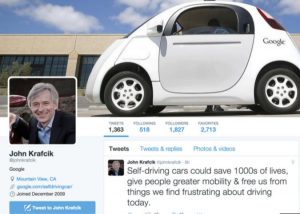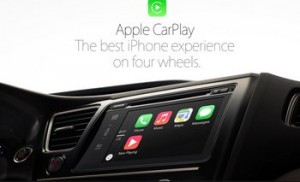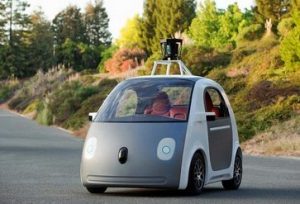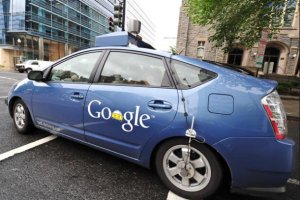 Autonomous vehicles was a central theme at AltCar Expo in Santa Monica, Calif., on Friday, during its 10th anniversary conference. USA Today’s Chris Woodyard moderated a panel called “Automated Vehicles, Uber Autonomous Driving Now.” The lunchtime keynote speaker was Tony Seba, a lecturer at Stanford University and author of a book on disruption in clean energy and transportation; Seba was the keynoter last year and was popular and controversial enough to be invited back. One of his revolutionary forecasts is that all new vehicle sales in U.S. will be electrified and autonomous by 2030.
Autonomous vehicles was a central theme at AltCar Expo in Santa Monica, Calif., on Friday, during its 10th anniversary conference. USA Today’s Chris Woodyard moderated a panel called “Automated Vehicles, Uber Autonomous Driving Now.” The lunchtime keynote speaker was Tony Seba, a lecturer at Stanford University and author of a book on disruption in clean energy and transportation; Seba was the keynoter last year and was popular and controversial enough to be invited back. One of his revolutionary forecasts is that all new vehicle sales in U.S. will be electrified and autonomous by 2030.
Right after Seba, an impressive group of panelists discussed deploying autonomous vehicles. The Los Angeles County Economic Development Corporation’s (LAEDC’s) e4Mobility Alliance organized the panel, “From Research to Reality: Deploying Autonomous Vehicles.” The panel was moderated by Tom Paige of Urban Systems Laboratories and also featured comments from state Senator Ben Allen, who serves on the state’s Transportation and Housing committee, and the Select Committee on Ports and Goods Movement. Speakers included Geoff Wardle, Director of Advanced Mobility Research, Art Center College of Design; Naveen Berry, Technology Demonstration Manager, South Coast Air Quality Management District; Alan Clelland, Sr. VP & General Manager at Iteris Transportation System Division; and Aravind Kaillas, ITS Research Engineer at The Volvo Group, who commented on the commercial truck side of the topic. The e4Mobility Alliance has taken quite a lot of interest in autonomous vehicles this year, including passenger vehicles, cargo transport, neighborhood electric vehicles, and targeted applications (which could be utilized at airports, universities, corporate campuses, living facilities, etc.)
Earlier that week, TrueCar President John Krafcik shocked a few people announcing his new position heading up Google Inc.’s self-driving car project. While TrueCar’s future is in question with founder Scott Painter leaving soon, why would Krafcik choose Google over another automaker? He’d been praised for leading Hyundai to record U.S. sales, and would surely be offered an executive position with an OEM or tier 1 supplier. What’s behind the Google move?
Then there were comments made last week by Daimler CEO Dieter Zetsche to Reuters that Mercedes-Benz is thinking about starting up a business unit that would provide on-demand limousine service without a chauffeur; the company may create an extensive fleet of autonomous vehicles to reach consumers who want on-demand transportation services much more than owning a car. What’s behind this thinking?
Automotive engineers don’t think autonomous vehicles will make it to our roads in any real numbers until the 2030-to-2035 timeframe – according to a study last year by the Institute of Electrical and Electronic Engineers (IEEE). That’s at least 15 years from now. Here are a few points to consider on why autonomous, driverless cars have become the disruptive technology of the year.
- Race to Be Leading Auto Tech Company: Google is competing with Apple and Microsoft to be the leading automotive technology partner. While Google has been testing a small fleet of its own self-driving cars in the past year, company executives have stated they don’t want to become an auto manufacturer. That same question has come up for Apple lately as the technology giant tests out autonomous and electrified vehicles. Google, Apple, and Microsoft have been investing heavily in becoming the leading supplier of mobile applications and devices, and software connecting cars to smart phones, telematics, and infotainment features. Google through Android Auto, Apple through CarPlay, and Microsoft with its Windows Embedded Automotive 7, are the latest offerings built around becoming the leading connected car technology systems company.
- Marriage of Detroit and Silicon Valley: Krafcik will take the helm from Chris Urmson, the former head of the Google self-driving car technology. Krafcik combines engineering and marketing, which is one of the secret formulas behind success in the automotive market. He worked as a mechanical engineer at Ford Motor Co. from 1990 to 2004, where he served as chief engineer for the Expedition and Navigator SUVs. He spent 10 years with Hyundai Motor Co., with five years as the president and CEO of its U.S. division. He led the charge in boosting the automaker’s U.S. sales and market share. Google’s job offer indicates the company wants to be taken seriously by automakers as the leading technology supplier in driverless cars. Other major suppliers like Continental Automotive and Delphi are deeply engaged in testing out driverless car technologies; Google clearly wants to be seen as the leading voice out there in the marriage of Detroit and Silicon Valley.
- Morphing Automakers: Daimler’s announcement has led to comparison to ubiquitous ridesharing startup Uber – but Daimler has already played a sizable role in the sharing economy. Its carsharing division, Car2Go, is considered by some to be even more substantial than Zipcar in leading the carsharing space. Carsharing is taking off with users and revenues at a fast pace in the past couple of years – just like Uber is seeing dramatic growth in rides. Daimler executives like Zetsche have been talking about the changing role of global automakers in recent years. Daimler, along with BMW, Ford, Toyota, Honda, GM, and Nissan, have been investing heavily in new technologies, research centers in Silicon Valley, and new business models like Car2Go. Some of that has to do with ambitious fuel economy and emissions reductions mandated in the U.S. and Europe, which is a key reason that automakers continue announcing electric vehicle new vehicle launches. There may be something even larger on the horizon. Futurists say that the identity of automakers will change dramatically in the next 15 years – from vehicle manufacturers to mobility companies. Along with environmental concerns, there’s also safety and mobility issues surrounding the “urbanization” trend – where young people are moving into cities and have less interest in owning cars.
- Leading Advanced Technology OEM: Tesla Motors is emphasizing its leading role in self-driving car technologies through its Autopilot features available as an option with its Model S and upcoming Model X. Tesla’s Autopilot software helps the car maintain its place within a lane and its following distance, as well as manage its acceleration and braking. You can change lanes by switching on the turn indicator and the car will do the rest – moving you automatically to that lane when it’s safe to do so. Autopilot is expected to feature a 360-degree ultrasonic sonar that will monitor everything within a radius to make sure the car stays safely on the road. Every major automaker has connected car features that have been rolling out in recent years – with safety, fuel efficiency, connectivity, and convenience being emphasized. Why would an electric vehicle manufacturer jump into the self-driving car race? The future of the auto industry doesn’t boil down to one leading technology like hybrid or electric powertrains. All of the bases need to be covered for building brand identity and selling more cars. These days, OEMs are racing to be No. 1 in global sales along with being sustainable, efficient, safe, profitable, and the leader in advanced vehicle technologies.
- “Semi-Autonomous” Vehicles: Autonomous vehicles may never become 100% driverless in the future, and “semi-autonomous” may be more accurate; the main issue being instantaneous highway disasters like a car crash where the driver needs to take over to save lives. Automakers are well on their way to offering the safest and best technologies – some of them being classic like GM rolling out cruise control features in its product lineup. Audi is testing out self-parking car systems, which should be a big hit with car shoppers. “Connected cars” is probably a more accurate search term for where automakers will be investing heavily in finances, intellectual property, and talented staff over the next 10 years – and it could be the same thing as semi-autonomous. The connected car concept is built around tapping into available data to maximize a vehicle’s performance, safety, and convenience. Some experts (including Automotive Digest Publisher Chuck Parker) expect to see limited test applications for connected, semi-autonomous systems in the next few years – such as industrial vehicles or controlled environments like universities or corporate campuses.
- Why Uber Says it Will Go Driverless: In May 2014, Uber CEO Travis Kalanick made comments about Uber going driverless. It was a day after Google unveiled the prototype for its own driverless vehicle. That would bring down the largest cost of an Uber ride and increase profits dramatically for the company, but that lofty goal is very far away. As for today, Uber spends a lot of money on advertising to bring in more drivers and their cars. Why would Uber emphasize driverless cars? For one thing, Google Ventures is one of the largest investors in Uber (which may go public on the stock market). Perhaps Uber will play a role in Google’s heavy investment in self-driving car technologies? It could be an excellent client for Google to work with, and a technology testing platform with great potential. Kalanick has also made comments about wanting its fleet to be made up of Tesla vehicles with the Autopilot systems in place. Uber has also been participating in the Carnegie Mellon driverless car test program in the past year. The ride-sharing company’s self-driving prototype was spotted in Pittsburgh with “Uber Advanced Technologies Center” appearing on the test car. “This vehicle is part of our early research efforts regarding mapping, safety, and autonomy systems,” a company spokesperson said. Uber’s executives, based in San Francisco, seem to enjoy being part of the Silicon Valley clique with Google and Tesla. The company also hopes to one day not have to pay its drivers; as for now Uber has been enjoying having its name quoted all over the media and being the epicenter of one of the coolest, cutting edge technologies out there. They’d be foolish to ignore the viral buzz around self-driving cars.



